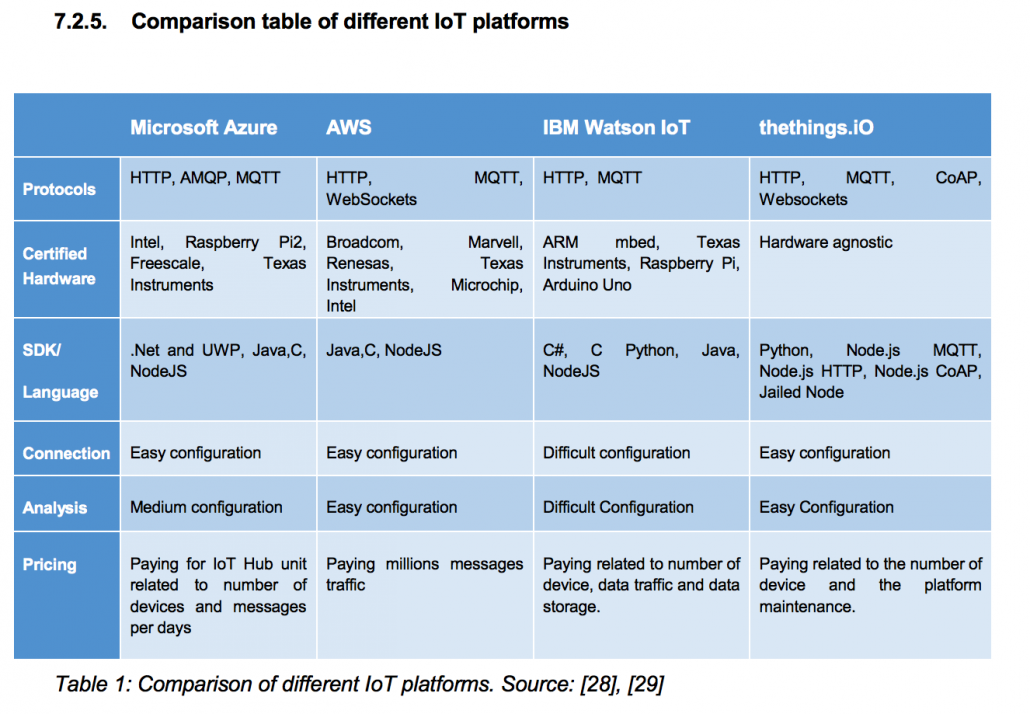Benchmark IoT platforms for Sigfox products
This post and project has been developed by Daniel Torn Mercad graduated in Industrial Engineering at ETSEIB-UPC and it has been mentored by Manuel Moreno Egulaz UPC Senior Researcher. Further information of how to configure the platforms can be found here onDaniel Torn master thesis.
This is the result table of comparing the different IoT platforms AWS IoT, Microsoft Azure IoT, thethings.iO and IBM Watson.
Today we have the pleasure to publish an invited guest post made by a UPC student. Daniel Torn Mercad was a student of the Department of Electronic Engineering at ETSEIB-UPC and he has been working on a master thesis named Comparison of different Internet of Things Platforms. Dani tested different IoT platforms such as AWS, IBM Watson IoT, Microsoft Azure andthethings.iOusing the data provided by a temperature sensor of a Sigfox device and today he is going to explain the benchmark of all of these IoT platforms with Sigfox.
In relation to thethethings.iO IoT platform, it has been configured in order to receive the data from the Sigfox Cloud with the provided Callback URL. Then, by means of a Sigfox parser, the data has been addressed and given an attribute. Finally, a table and a graphic visualization have been created in order to watch the trend of the temperature during a period of time.
On his master thesis the student configured a Sigfox device with several IoT platforms. The Sigfox device is sending periodically temperature readings to the Sigfox Cloud and these are sent from there to the different IoT platforms, which have been configured to receive and store the data. Once the data is stored in the IoT platforms, the main objective is to get useful insight from them. Therefore, graphical visualizations have been carried out. The report explains in detail how to configure these platforms in order to receive and analyze data, conveyed by a Sigfox device.
With reference to the strengths of thethings.iO IoT platform, it can be stated that it is simple to configure the connection between the Sigfox Cloud and the thethings.iO platform. Moreover, it has a different internal structure than the other platforms which makes relatively easy to make an analysis right after the data reaches the platforms in comparison with the other IoT platforms. A feature that singles outthethings.iOIoT platform is that it is software and hardware agnostic, therefore, it can be connected to any device whereas the other platforms had a few group of hardware to which they can be connected.

Geocoding location coordinates to addresses from GPS-trackers
How to integrate Prometheus time series with thethings.iO IoT platform
The steps followed to connect the Sigfox devices are much simpler withthethings.iOthan the steps done in the other IoT platforms. The physical thing, which corresponds to the Sigfox device, which is conveying data, is registered / provisioned in the IoT platform cloud automatically and the data automatically stored after generating a Sigfox payload parser.
How to integrate LoRa with thethings.iO IoT platform
The added value provided by this project is that the reader can get a broader vision of how to configure and deploy an IoT architecture and, more importantly, which IoT platformbetter fits with the requirements of each and every project. To make things easier, a comparison of the platforms, considering features such as easiness to connect and data analysis, pricing, flexibility or services, has been checked.
3 Reasons to Start Tracking Your Assets on the Supply Chain with IoT
Create custom dashboards with drag&drop widgets, monitor your hardware and analyze your customers.

